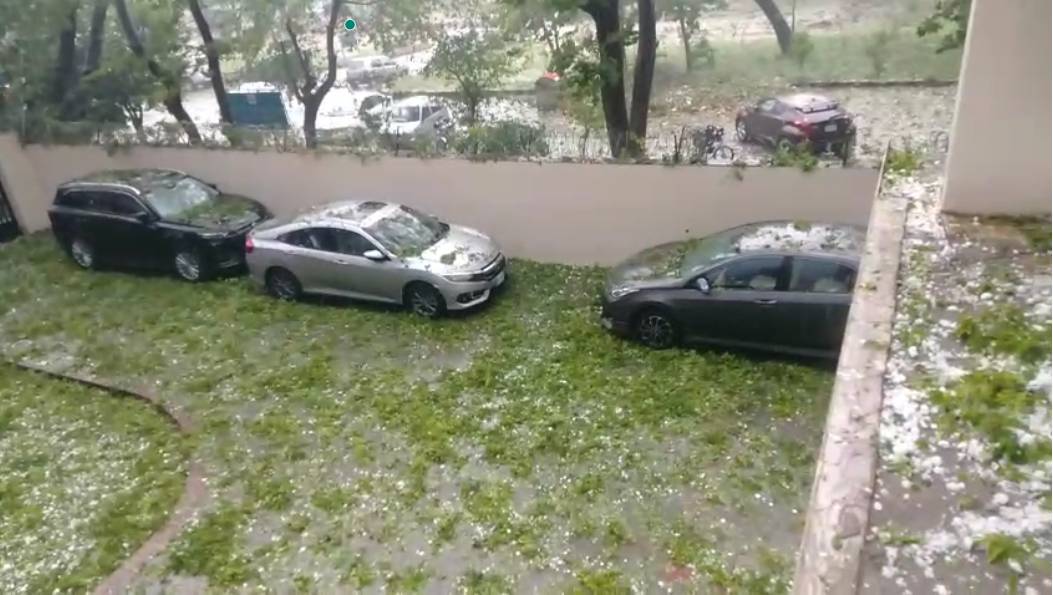A sudden and intense hailstorm hit Islamabad on April 17, 2025, leaving behind a trail of destruction. The storm, which lasted only a short while, brought golf ball-sized hailstones that caused severe damage to homes, vehicles, trees, and solar systems. The hailstorm caught residents across various sectors of the capital off guard, and many described it as one of the most damaging Islamabad has witnessed in years.
What Happened?
The storm struck unexpectedly in the evening, accompanied by strong winds and a sudden drop in temperature. The sky turned dark as thick clouds rolled in, followed by a heavy downpour mixed with large hail. Within minutes, roads and rooftops were covered with white hailstones, resembling snowfall.
Most Affected Areas
The worst-hit regions were the sectors along Margalla Road. In particular, sectors D-12 to F-7 bore the brunt of the hailstorm. Residents reported golf ball-sized hailstones battering their windows, vehicles, and rooftops. Streets were layered in white from the hail, and green from the shattered leaves and branches of trees. The storm’s impact on vegetation was clear, with fallen trees, snapped branches, and flattened plants spread across the roads.
Property and Vehicle Damage
One of the major concerns was the widespread damage to private property. Many solar systems were severely damaged, with solar plates broken or completely destroyed. The windows of numerous homes shattered under the pressure of the hail. People shared pictures and videos on social media showing broken glass, flooded rooms, and damaged interiors.
Cars parked on the streets or in open areas were not spared either. The large hailstones caused significant dents, broke windshields, and damaged side mirrors. The hailstorm ripped off bumpers in some cases and punched holes into the bodies of vehicles. Many found it terrifying, especially those caught outside or without covered parking.
Power Outages and Traffic Jams
The storm also disrupted power lines in some areas, causing short-term outages. With fallen trees and scattered debris on roads, traffic came to a standstill in many parts of the city. Commuters faced long delays and road blockages due to the debris and slippery conditions.
Voices from the Ground
Many residents expressed their shock and concern over the storm’s intensity. “We’ve seen hail before, but never like this. The hailstones were so big, it felt like someone was throwing rocks at the windows,” said a resident of F-7. Others pointed out the need for better weather alerts and preparation systems to avoid future losses.
Environmental Impact
The hailstorm had a noticeable impact on the city’s natural greenery. The force of the hail destroyed countless trees and plants, leaving roads and parks filled with broken branches and leaves. Clean-up crews were seen clearing the roads the next morning, but the damage to Islamabad’s urban forest may take months to recover.
Safety Tips for Future Storms
With weather patterns becoming more unpredictable, here are a few tips to stay safe:
- Always check weather updates before heading out.
- Install protective sheets or hail covers on solar panels.
- Park your car under shelter whenever possible.
- Keep emergency kits ready at home.
- Strengthen windows with protective films if you live in hail-prone areas.
Final Thoughts | Hailstorm Islamabad
The hailstorm in Islamabad was a harsh reminder of how quickly nature can turn. Sectors from D-12 to F-7, following the Margalla road experienced significant loss, with broken solar systems, damaged cars, shattered windows, and uprooted greenery. As the city recovers, it’s important for authorities and residents to work together in planning better infrastructure and awareness for weather emergencies.
